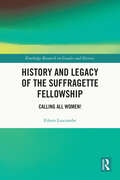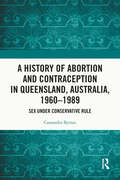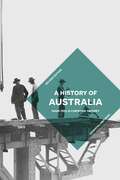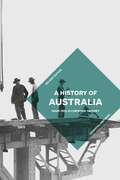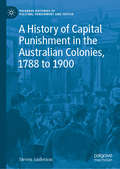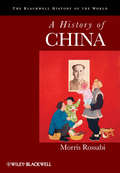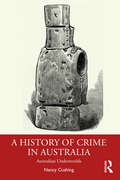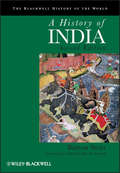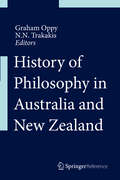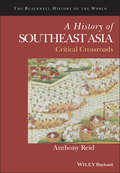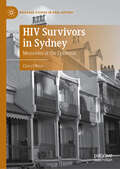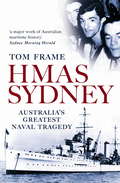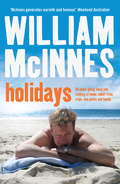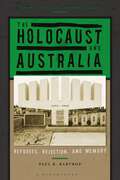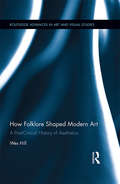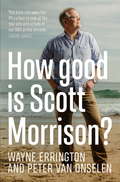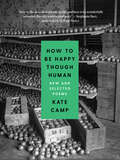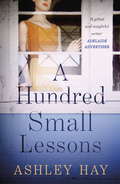- Table View
- List View
History and Legacy of the Suffragette Fellowship: Calling all Women! (Routledge Research in Gender and History)
by Eileen LuscombeHistory and Legacy of the Suffragette Fellowship provides a biographical account of the scope and depth of the memory work of the now-forgotten commemorative group the Suffragette Fellowship, active from the 1920s to the 1970s. The Suffragette Fellowship comprised members from the militant suffrage groups known as the Women’s Social and Political Union, the Women’s Freedom League, and the Actress Franchise League. This research provides a comprehensive analysis of the Fellowship’s attempts to form and sustain a collective Suffragette identity across four decades of activity. It considers the legacy of contested histories attached to militant campaigning that pressured Fellowship leaders to take control of the public memory of suffrage history. With close attention given to a neglected piece of feminist history, this book highlights the cultural and political impacts that the Fellowship enacted in their memory of the women’s suffrage movement. Richly illustrated with images of members, artefacts, and publications, this extensive study of the Suffragette Fellowship adds to transnational suffrage histories in the United Kingdom and Australia and will be of interest to scholars in memory studies and women’s history.
History and Legacy of the Suffragette Fellowship: Calling all Women! (Routledge Research in Gender and History)
by Eileen LuscombeHistory and Legacy of the Suffragette Fellowship provides a biographical account of the scope and depth of the memory work of the now-forgotten commemorative group the Suffragette Fellowship, active from the 1920s to the 1970s. The Suffragette Fellowship comprised members from the militant suffrage groups known as the Women’s Social and Political Union, the Women’s Freedom League, and the Actress Franchise League. This research provides a comprehensive analysis of the Fellowship’s attempts to form and sustain a collective Suffragette identity across four decades of activity. It considers the legacy of contested histories attached to militant campaigning that pressured Fellowship leaders to take control of the public memory of suffrage history. With close attention given to a neglected piece of feminist history, this book highlights the cultural and political impacts that the Fellowship enacted in their memory of the women’s suffrage movement. Richly illustrated with images of members, artefacts, and publications, this extensive study of the Suffragette Fellowship adds to transnational suffrage histories in the United Kingdom and Australia and will be of interest to scholars in memory studies and women’s history.
A History of Abortion and Contraception in Queensland, Australia, 1960–1989: Sex under Conservative Rule
by Cassandra ByrnesThis book looks at the recent history of sex, contraception, and abortion in Australia’s most conservative state, Queensland. In western nations, there has largely been a consistent increase in available contraception and access to abortion from the 1960s onwards, yet there are a few geographical exceptions that resisted this trend, including Queensland.Cassandra Byrnes highlights the multifarious ways sexuality and reproduction were continually constructed and challenged during the second half of the twentieth century and follows the responses of key groups to changing laws and attitudes in a time of local and global sexual and social revolutions. She explores interactions between identities of gender, sexuality, class, age, marital status, and geography to illustrate how specific sexed bodies became liminal sites for legal and medical debate.This Queensland case study is contextualised within international debates concerning women’s reproductive rights and will be of interest to students and scholars interested in the history of reproductive rights, gender, and sexuality.
A History of Abortion and Contraception in Queensland, Australia, 1960–1989: Sex under Conservative Rule
by Cassandra ByrnesThis book looks at the recent history of sex, contraception, and abortion in Australia’s most conservative state, Queensland. In western nations, there has largely been a consistent increase in available contraception and access to abortion from the 1960s onwards, yet there are a few geographical exceptions that resisted this trend, including Queensland.Cassandra Byrnes highlights the multifarious ways sexuality and reproduction were continually constructed and challenged during the second half of the twentieth century and follows the responses of key groups to changing laws and attitudes in a time of local and global sexual and social revolutions. She explores interactions between identities of gender, sexuality, class, age, marital status, and geography to illustrate how specific sexed bodies became liminal sites for legal and medical debate.This Queensland case study is contextualised within international debates concerning women’s reproductive rights and will be of interest to students and scholars interested in the history of reproductive rights, gender, and sexuality.
A History of Australia (Macmillan Essential Histories)
by Mark Peel Christina TwomeyThis vivid, multi-dimensional history considers the key cultural, social, political and economic events of Australia’s history. Deftly weaving these issues into the wider global context, Mark Peel and Christina Twomey provide an engaging overview of the country’s past, from its first Indigenous people, to the great migrations of recent centuries, and to those living within the more anxiously controlled borders of the present day. This engaging textbook is an ideal resource for undergraduate students and postgraduate students taking modules or courses on the History of Australia. It will also appeal to general readers who are interested in obtaining a thorough overview of the entire history of Australia, from the earliest times to the present, in one concise volume.
A History of Australia (Macmillan Essential Histories)
by Mark Peel Christina TwomeyThis vivid, multi-dimensional history considers the key cultural, social, political and economic events of Australia's history. Deftly weaving these issues into the wider global context, Mark Peel and Christina Twomey provide an engaging overview of the country's past, from its first Indigenous people, to the great migrations of recent centuries, and to those living within the more anxiously controlled borders of the present day.This engaging textbook is an ideal resource for undergraduate students and postgraduate students taking modules or courses on the History of Australia. It will also appeal to general readers who are interested in obtaining a thorough overview of the entire history of Australia, from the earliest times to the present, in one concise volume.
A History of Capital Punishment in the Australian Colonies, 1788 to 1900 (Palgrave Histories of Policing, Punishment and Justice)
by Steven AndersonThis book provides a comprehensive overview of capital punishment in the Australian colonies for the very first time. The author illuminates all aspects of the penalty, from shortcomings in execution technique, to the behaviour of the dying criminal, and the antics of the scaffold crowd. Mercy rates, execution numbers, and capital crimes are explored alongside the transition from public to private executions and the push to abolish the death penalty completely. Notions of culture and communication freely pollinate within a conceptual framework of penal change that explains the many transformations the death penalty underwent. A vast array of sources are assembled into one compelling argument that shows how the ‘lesson’ of the gallows was to be safeguarded, refined, and improved at all costs. This concise and engaging work will be a lasting resource for students, scholars, and general readers who want an in-depth understanding of a long feared punishment.Dr. Steven Anderson is a Visiting Research Fellow in the History Department at The University of Adelaide, Australia. His academic research explores the role of capital punishment in the Australian colonies by situating developments in these jurisdictions within global contexts and conceptual debates.
A History of China (Blackwell History of the World)
by Morris RossabiCapturing China’s past in all its complexity, this multi-faceted history portrays China in the context of a larger global world, while incorporating the narratives of Chinese as well as non-Chinese ethnic groups and discussing people traditionally left out of the story—peasants, women, merchants, and artisans. Offers a complete political, economic, social, and cultural history of China, covering the major events and trends Written in a clear and uncomplicated style by a distinguished historian with over four decades of experience teaching undergraduates Examines Chinese history through the lens of global history to better understand how foreign influences affected domestic policies and practices Depicts the role of non-Chinese ethnic groups in China, such as Tibetans and Uyghurs, and analyzes the Mongol and Manchu rulers and their impact on Chinese society Incorporates the narratives of people traditionally left out of Chinese history, including women, peasants, merchants, and artisans
A History of China (Blackwell History of the World)
by Morris RossabiCapturing China’s past in all its complexity, this multi-faceted history portrays China in the context of a larger global world, while incorporating the narratives of Chinese as well as non-Chinese ethnic groups and discussing people traditionally left out of the story—peasants, women, merchants, and artisans. Offers a complete political, economic, social, and cultural history of China, covering the major events and trends Written in a clear and uncomplicated style by a distinguished historian with over four decades of experience teaching undergraduates Examines Chinese history through the lens of global history to better understand how foreign influences affected domestic policies and practices Depicts the role of non-Chinese ethnic groups in China, such as Tibetans and Uyghurs, and analyzes the Mongol and Manchu rulers and their impact on Chinese society Incorporates the narratives of people traditionally left out of Chinese history, including women, peasants, merchants, and artisans
A History of Crime in Australia: Australian Underworlds
by Nancy CushingThis book provides a lively and accessible account of Australia’s most prominent crimes and criminals of the nineteenth and twentieth century and offers an informative background for those seeking to understand crimes committed today. A History of Crime in Australia examines the imposition of English law on this ancient continent, and how its operation affected both transported offenders from Great Britain and Ireland, and the Aboriginal and Torres Strait Islander peoples whose own systems of Law were overlaid. Drawing upon cutting-edge research in the field, original work by the author, and essays from leading crime history researchers, it addresses the question of whether there was an Australian underworld. In doing so, it provides background for well known offenders including bushranger Ned Kelly and the razor gangs of the 1920s and for sensational crimes like the Mount Rennie Outrage, the Pyjama Girl Mystery and the Shark Arm Murder and the miscarriage of justice following the disappearance of Azaria Chamberlain at Uluru in 1980. Through these case studies, the book draws out points of tension and cohesion within Australian society, exposing the enduring anxiety around those who were considered to be outsiders, and how the criminal justice system was used to manage these concerns. This book includes a guide to conducting research in the field of Australian crime history and sources for further study. Designed as an introductory text for students, this book will be of interest to those studying criminology and crime history, and anyone who would like to deepen their understanding of crime’s place in Australia’s social and cultural history.
A History of Crime in Australia: Australian Underworlds
by Nancy CushingThis book provides a lively and accessible account of Australia’s most prominent crimes and criminals of the nineteenth and twentieth century and offers an informative background for those seeking to understand crimes committed today. A History of Crime in Australia examines the imposition of English law on this ancient continent, and how its operation affected both transported offenders from Great Britain and Ireland, and the Aboriginal and Torres Strait Islander peoples whose own systems of Law were overlaid. Drawing upon cutting-edge research in the field, original work by the author, and essays from leading crime history researchers, it addresses the question of whether there was an Australian underworld. In doing so, it provides background for well known offenders including bushranger Ned Kelly and the razor gangs of the 1920s and for sensational crimes like the Mount Rennie Outrage, the Pyjama Girl Mystery and the Shark Arm Murder and the miscarriage of justice following the disappearance of Azaria Chamberlain at Uluru in 1980. Through these case studies, the book draws out points of tension and cohesion within Australian society, exposing the enduring anxiety around those who were considered to be outsiders, and how the criminal justice system was used to manage these concerns. This book includes a guide to conducting research in the field of Australian crime history and sources for further study. Designed as an introductory text for students, this book will be of interest to those studying criminology and crime history, and anyone who would like to deepen their understanding of crime’s place in Australia’s social and cultural history.
A History of India
by Burton SteinThis new edition of Burton Stein's classic A History of India builds on the success of the original to provide an updated narrative of the development of Indian society, culture, and politics from 7000 BC to the present. New edition of Burton Stein’s classic text provides a narrative from 7000 BC up to the twenty-first century Includes updated and extended coverage of the modern period, with a new chapter covering the death of Nehru in 1964 to the present Expands coverage of India's internal political and economic development, and its wider diplomatic role in the region Features a new introduction, updated glossary and further reading sections, and numerous figures, photographs and fully revised maps
A History of Southeast Asia: Critical Crossroads (Blackwell History of the World)
by Anthony ReidA History of Southeast Asia: Critical Crossroads presents a comprehensive history of Southeast Asia from our earliest knowledge of its civilizations and religious patterns up to the present day. Incorporates environmental, social, economic, and gender issues to tell a multi-dimensional story of Southeast Asian history from earliest times to the present Argues that while the region remains a highly diverse mix of religions, ethnicities, and political systems, it demands more attention for how it manages such diversity while being receptive to new ideas and technologies Demonstrates how Southeast Asia can offer alternatives to state-centric models of history more broadly 2016 PROSE Award Honorable Mention for Textbook in the Humanities
A History of Southeast Asia: Critical Crossroads (Blackwell History of the World)
by Anthony ReidA History of Southeast Asia: Critical Crossroads presents a comprehensive history of Southeast Asia from our earliest knowledge of its civilizations and religious patterns up to the present day. Incorporates environmental, social, economic, and gender issues to tell a multi-dimensional story of Southeast Asian history from earliest times to the present Argues that while the region remains a highly diverse mix of religions, ethnicities, and political systems, it demands more attention for how it manages such diversity while being receptive to new ideas and technologies Demonstrates how Southeast Asia can offer alternatives to state-centric models of history more broadly 2016 PROSE Award Honorable Mention for Textbook in the Humanities
HIV Survivors in Sydney: Memories of the Epidemic (Palgrave Studies in Oral History)
by Cheryl WareInner-city Sydney was the epicenter of gay life in the Southern hemisphere in the 1970s and early 1980s. Gay men moved from across Australasia to find liberation in the city’s vibrant community networks; and when HIV and AIDS devastated those networks, they grieved, suffered, and survived in ways that have often been left out of the historical record. This book excavates the intimate lives and memories of HIV-positive gay men in Sydney, focusing on the critical years between 1982 and 1996, when HIV went from being a terrifying unidentified disease to a chronic condition that could be managed with antiretroviral medication. Using oral histories and archival research, Cheryl Ware offers a sensitive, moving exploration of how HIV-positive gay men navigated issues around disclosure, health, sex, grief, death, and survival. HIV Survivors in Sydney reveals how gay men dealt with the virus both within and outside of support networks, and how they remember these experiences nearly three decades later.
HMAS Sydney
by Tom FrameThe complete and authoritative account of the sinking of the HMAS Sydney, and the recent finding of her wreck.On 19 November 1941, the pride of the Australian Navy, the light cruiser Sydney, fought a close-quarters battle with the German armed raider HSK Kormoran off Carnarvon on the West Australian coast. Both ships sank – and not one of the 645 men on board the Sydney survived. Was Sydney’s captain guilty of negligence by allowing his ship to manoeuvre within range of Kormoran’s guns? Did the Germans feign surrender before firing a torpedo at the Sydney as she prepared to despatch a boarding party? This updated edition covers the recent discovery of the wreck – with the light this sheds on the events of that day 67 years ago, and the closure it has brought to so many grieving families. ‘Tom Frame has produced the most comprehensive and compelling account of the loss of HMAS Sydney to date. His judgements are fair and his conclusions reasoned. If you only read one book on this tragic event in Australian naval history, and want all the facts and theories presented in a balanced way, Tom Frame’s book is for you’ - Vice Admiral Russ Shalders AO CSC RANR Chief of Navy, 2005-08.
Holidays: All About Going Away And Staying At Home, About Train Trips, Lion Parks And Family
by William McInnesFrom bestselling author William McInnes, a book about the languid, unending holidays of summer; it's about going away and staying at home, about sunburn, seagulls, family and friends.Remember those long, languid holidays when the only decisions to be made were what to pack in the Esky and who should get the front seat on the drive to the beach?Let William McInnes reignite your nostalgia for holidays past, and give you a taste of the boundless opportunities that await in holidays to come in this book about our love affair with life away from the everyday.This book will take you back to the holidays you had as a kid and remind you of the ones you've had with your own family or friends or even the ones where you've flown solo.Holidays are the runway to possibilities - a romantic sunset, the spare seat at breakfast being taken by an attractive stranger, a miraculous airline upgrade - or missing bags, unfortunate rashes and wrong turns that lead to places you definitely did not intend to go. Whether you are away from home and somewhere exotic or just in your own backyard on a lilo in an above-ground pool, whatever happens, you know that life is sweet because you're on HOLIDAYS.**Includes a bonus extract from William's hilarious and heartwarming memoir Fatherhood**"McInnes is a natural storyteller . . ." - Sun Herald, Sydney"McInnes enjoys a quirky love affair with the quintessential Australian holiday" - Brisbane News"Proves that the journey is just as agreeable as the destination" - Sunday Age". . . full of beautifully crafted childhood reminiscences and anecdotes" - Sunday Examiner"McInnes is a wonderfully engaging writer - witty and warm and a master of a good yarn. If your holidays aer a way off, curl up with William and he'll take you away" - Adelaide Advertiser
The Holocaust and Australia: Refugees, Rejection, and Memory (Perspectives on the Holocaust)
by Paul R. BartropPaul R. Bartrop examines the formation and execution of Australian government policy towards European Jews during the Holocaust period, revealing that Australia did not have an established refugee policy (as opposed to an immigration policy) until late 1938. He shows that, following the Evian Conference of July 1938, Interior Minister John McEwen pledged a new policy of accepting 15,000 refugees (not specifically Jewish), but the bureaucracy cynically sought to restrict Jewish entry despite McEwen's lofty ambitions. Moreover, the book considers the (largely negative) popular attitudes toward Jewish immigrants in Australia, looking at how these views were manifested in the press and in letters to the Department of the Interior. The Holocaust and Australia grapples with how, when the Second World War broke out, questions of security were exploited as the means to further exclude Jewish refugees, a policy incongruous alongside government pronouncements condemning Nazi atrocities. The book also reflects on the double standard applied towards refugees who were Jewish and those who were not, as shown through the refusal of the government to accept 90% of Jewish applications before the war. During the war years this double standard continued, as Australia said it was not accepting foreign immigrants while taking in those it deemed to be acceptable for the war effort. Incorporating the voices of the Holocaust refugees themselves and placing the country's response in the wider contexts of both national and international history in the decades that have followed, Paul R. Bartrop provides a peerless Australian perspective on one of the most catastrophic episodes in world history.
The Holocaust and Australia: Refugees, Rejection, and Memory (Perspectives on the Holocaust)
by Paul R. BartropPaul R. Bartrop examines the formation and execution of Australian government policy towards European Jews during the Holocaust period, revealing that Australia did not have an established refugee policy (as opposed to an immigration policy) until late 1938. He shows that, following the Evian Conference of July 1938, Interior Minister John McEwen pledged a new policy of accepting 15,000 refugees (not specifically Jewish), but the bureaucracy cynically sought to restrict Jewish entry despite McEwen's lofty ambitions. Moreover, the book considers the (largely negative) popular attitudes toward Jewish immigrants in Australia, looking at how these views were manifested in the press and in letters to the Department of the Interior. The Holocaust and Australia grapples with how, when the Second World War broke out, questions of security were exploited as the means to further exclude Jewish refugees, a policy incongruous alongside government pronouncements condemning Nazi atrocities. The book also reflects on the double standard applied towards refugees who were Jewish and those who were not, as shown through the refusal of the government to accept 90% of Jewish applications before the war. During the war years this double standard continued, as Australia said it was not accepting foreign immigrants while taking in those it deemed to be acceptable for the war effort. Incorporating the voices of the Holocaust refugees themselves and placing the country's response in the wider contexts of both national and international history in the decades that have followed, Paul R. Bartrop provides a peerless Australian perspective on one of the most catastrophic episodes in world history.
How Folklore Shaped Modern Art: A Post-Critical History of Aesthetics (Routledge Advances in Art and Visual Studies)
by Wes HillSince the 1990s, artists and art writers around the world have increasingly undermined the essentialism associated with notions of "critical practice." We can see this manifesting in the renewed relevance of what were previously considered "outsider" art practices, the emphasis on first-person accounts of identity over critical theory, and the proliferation of exhibitions that refuse to distinguish between art and the productions of culture more generally. How Folklore Shaped Modern Art: A Post-Critical History of Aesthetics underscores how the cultural traditions, belief systems and performed exchanges that were once integral to the folklore discipline are now central to contemporary art’s "post-critical turn." This shift is considered here as less a direct confrontation of critical procedures than a symptom of art’s inclusive ideals, overturning the historical separation of fine art from those "uncritical" forms located in material and commercial culture. In a global context, aesthetics is now just one of numerous traditions informing our encounters with visual culture today, symptomatic of the pull towards an impossibly pluralistic image of art that reflects the irreducible conditions of identity.
How Folklore Shaped Modern Art: A Post-Critical History of Aesthetics (Routledge Advances in Art and Visual Studies #15)
by Wes HillSince the 1990s, artists and art writers around the world have increasingly undermined the essentialism associated with notions of "critical practice." We can see this manifesting in the renewed relevance of what were previously considered "outsider" art practices, the emphasis on first-person accounts of identity over critical theory, and the proliferation of exhibitions that refuse to distinguish between art and the productions of culture more generally. How Folklore Shaped Modern Art: A Post-Critical History of Aesthetics underscores how the cultural traditions, belief systems and performed exchanges that were once integral to the folklore discipline are now central to contemporary art’s "post-critical turn." This shift is considered here as less a direct confrontation of critical procedures than a symptom of art’s inclusive ideals, overturning the historical separation of fine art from those "uncritical" forms located in material and commercial culture. In a global context, aesthetics is now just one of numerous traditions informing our encounters with visual culture today, symptomatic of the pull towards an impossibly pluralistic image of art that reflects the irreducible conditions of identity.
How Good is Scott Morrison?
by Peter van Onselen Wayne ErringtonWithout fear or favour, How Good is Scott Morrison? examines the trials and tribulations of our 30th prime minister. Investigating Morrison's unlikely rise to the liberal leadership and his miracle electoral win, van Onselen and Errington put his leadership under the spotlight.Covering Morrison's disastrous management of the catastrophic bushfire season that was highlighted by the extraordinary statement, 'I don't hold the hose, mate,' and the decision to holiday while the country burned, How Good is Scott Morrison? shows his resolve and the redemption the government's response to the pandemic brought him.Right now, Scott Morrison seems unassailable and sure to win the next election, but what exactly is his vision for Australia? A pragmatist rather than an ideologue, he is a deeply Pentecostal religious man but he doesn't wear his faith as a badge of honour. So what does he really believe in?When the history of this period is written, Morrison will certainly be seen as an election winner but will he be viewed as having had the courage and vision to change Australia for the better, or the worse?
How to Be Happy Though Human: New and Selected Poems
by Kate CampA timely collection of new and previously published work by one of New Zealand’s most acclaimed poets, How to Be Happy Though Human introduces Kate Camp’s eclectic and musical poetry to international audiences for the first time.How to Be Happy Though Human: New and Selected Poems is Kate Camp’s seventh book of poetry and the first to be published outside New Zealand. Incorporating a grouping of new, previously unpublished work and a selection of important poems from her six earlier collections, this volume introduces North American readers to poetry that has been described by critics as “fearless,” “mesmerizing,” and “containing a surprising radicalism and power.”Camp’s work is recognized for its wide-ranging and eclectic subject matter, its technical control, and its musicality, with pop culture, high culture, the domestic confessional, close observation, and found language featured as recurring elements of style.A timely retrospective that represents a new chapter in Camp’s career, How to Be Happy Though Human promises to gain a wide readership for this thoughtful, engaging, and popular writer.
A Hundred Small Lessons: A Novel
by Ashley Hay'I love Ashley Hay's writing . . . it's so poised and beautiful.' Guardian'A moving and lyrical story of marriage, motherhood and age. Highly recommend.' Cari Rosen, author of The Secret Diary of a New Mum (Aged 43 1/4)When Elsie Gormley leaves the Brisbane house in which she has lived for more than sixty years, Lucy Kiss and her family move in, eager to establish their new life. As they settle in, Lucy and her husband Ben struggle to navigate their transformation from adventurous lovers to new parents, taking comfort in memories of their vibrant past as they begin to unearth who their future selves might be. But the house has secrets of its own, and the rooms seem to share recollections of Elsie's life with Lucy.In her nearby nursing home, Elsie traces the span of her life-the moments she can't bear to let go and the places to which she dreams of returning. Her beloved former house is at the heart of her memories of marriage, motherhood, love, and death, and the boundary between present and past becomes increasingly porous for both her and Lucy.Over the course of one hot Brisbane summer, two families' stories intersect in sudden and unexpected ways. Through the richly intertwined narratives of two ordinary, extraordinary women, Ashley Hay uses her lyrical prose, poetic dialogue, and stunning imagery to weave an intricate, bighearted story of what it is to be human.
